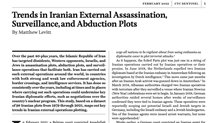In this month’s cover of @CTCWP I look at the who/what/where/when/why/how of Iranian external assassination, surveillance, & abduction plots, based on a personal dataset. ctc.usma.edu/february-2022/
A thread 🧵👇
A thread 🧵👇

2. This study is based on a dataset that includes 98 cases of assassination, abduction, attack, & surveillance plots by the #Iran regime from Dec 1979–Dec 2021 

3. WHO is targeted by #Iran? Of the 98 cases, 42 target dissidents, 31 target Jews/Israelis, 24 target diplomats, 24 target Western interests, & 7 target Gulf interests (note: some cases target multiple) 

4. In the last decade (55 cases), 22 target dissidents, 25 target Jews/Israelis, 19 target diplomats, 12 target Western interests, & 6 target Gulf interests 

5. Recent #Iran plots include a kidnapping plot vs journalist & human rights activist @AlinejadMasih. US Attorney Audrey Strauss said Masih’s “fate would have been uncertain at best”
nytimes.com/2021/07/13/nyr… @BenWeiserNYT
nytimes.com/2021/07/13/nyr… @BenWeiserNYT
6. WHO are #Iran ‘s perpetrators? Iranian operatives are preferred, but of 98 cases, 38 cases use non-Iranians/locals, 21 cases use dual nationals, and 7 cases outsource to criminal orgs 

7. #Iran and #Hezbollah have actively recruited and deployed dual-nationals for several years now. They are expected to travel & operate using their non-Iranian docs. I noted this trend in @CTCWP in 2020
ctc.usma.edu/fighters-witho…
ctc.usma.edu/fighters-witho…
8. In 2018, registered Iranian diplomat to Austria Assadollah Assadi plotted to bomb the annual @iran_policy conference in Paris, but this was just 1 example of #Iran using gov officials for terror
france24.com/en/live-news/2…
france24.com/en/live-news/2…
9. Iranian diplomats/operatives w/ diplomatic cover were involved in 22 plots in the dataset, including 13 in the past decade. I wrote about this phenomenon w/ @CTCWP in 2018
ctc.usma.edu/irans-deadly-d…
ctc.usma.edu/irans-deadly-d…
10. WHAT Iranian external ops are we talking about? Of the 98 cases in our dataset, 42 are assassination plots, 10 are abduction plots, 21 are indiscriminate attack plots, & 54 cases involve surveillance 

11. According to the dataset, pre-2011 most assassination plots used Iranian operatives (21/24), but in the past decade Iran has been just as likely to dispatch locals/non-Iranians & dual nationals as Iranians 

12. The 2011 #Iran plot targeting the Saudi ambassador to the US used Iranian-American dual national Mansour Arbabsiar. Following the arrest, @ODNIgov James Clapper testified that Iranian officials had “changed their calculus”
washingtonpost.com/world/national… @gregpmiller
washingtonpost.com/world/national… @gregpmiller
13. HOW does Iran attack + assassinate? Most cases use small arms or explosives, but bombs have become somewhat more common vs individuals & a couple of abduction cases have used sedatives 

14. The biggest recent development is use of cyber tools 4 surveillance & targeting. In 2012, #Iran recruited @usairforce intel specialist Monica Witt, who later researched USIC personnel & put together “target packages” on her former colleagues
fbi.gov/wanted/counter… @FBI
fbi.gov/wanted/counter… @FBI
15. Iranian operatives have used skillful tradecraft in some cases, but poor judgment in others. When police discovered a 2012 #Thailand plot, one operative threw an explosive at police & blew off his own legs
bbc.com/news/world-asi…
bbc.com/news/world-asi…

16. WHERE does #Iran operate? Of the 98 cases, 53 occurred in North America (14) or Europe (39), while 43 occurred in places like South America (4), Africa (10), Asia (21), & the Middle East (8) 

17. Of the 20 cases targeting US interests, 12 occurred outside the US in countries with more lax security systems—frequently in Central Asia, the Gulf, & Africa 

18. The WHEN & WHY of Iran attack planning are a lot harder to pin down. Iranian sticky bomb plots in 2012 were clear—they were part of its shadow war w/ the West after attacks on #Iran ’s nuclear program washingtoninstitute.org/policy-analysi…
19. Others like the Arbabsiar case are less clear. There is suspicion it was revenge after the crackdown on “Arab Spring” protesters in Bahrain. Can't know for sure using only open source data
cnn.com/2013/05/30/jus…
cnn.com/2013/05/30/jus…

20. Iran’s antipathy toward Israel is real, but most typically pursued via proxies. By acting through proxies like Lebanese #Hezbollah, #Iran manages risk & projects influence well beyond its borders. Note recent plot in Colombia
timesofisrael.com/hezbollah-plan…
timesofisrael.com/hezbollah-plan…

21. Maybe the biggest takeaway: Iran pursues plots in a very aggressive fashion, even at times and in places that are particularly sensitive (including JCPOA & current renewal talks) 

22. In some but not all Iranian plots, #Hezbollah operatives play a role. Details on these can be found on my Hezbollah Worldwide Activity Map & Timeline
washingtoninstitute.org/hezbollahinter…
washingtoninstitute.org/hezbollahinter…
23. For example, note Iran & #Hezbollah ops in South America. For more on #Hezbollah acting on behalf of #Iran in South America, check out this week’s episode of ‘Breaking Hezbollah’s Golden Rule’
washingtoninstitute.org/policy-analysi… @WashInstitute
washingtoninstitute.org/policy-analysi… @WashInstitute
24. This was a massive research project & I am tremendously grateful to @IlanaKrill (who has since moved on to work @gwupoe) and @LaurFredericks @WashInstitute for their research support
25. I love publishing with @CTCWP Sentinel, not only for its wide reach & smart readers, but for the tremendous editing of @CruickshankPaul @KristinaKHummel & their team. It's an honor to have this paper on the cover of this month's volume. Thank U! ctc.usma.edu/february-2022/ //END
• • •
Missing some Tweet in this thread? You can try to
force a refresh







